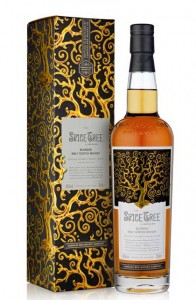By Richard Thomas
Rating: A-
In some circles, it is whispered that The Spice Tree is the whisk(e)y is the scotch the larger scotch industry doesn’t want you to have. Micro-distillery Compass Box first launched The Spice Tree in 2005, but were forced to discontinue production by the Scotch Whisky Association (SWA) under threat of legal action. The SWA objected to the use of French oak inner staves in the casks. These staves come from exactly the same source used in many of France’s finest wines: roughly 200 year old trees from the Vosges, which are then air seasoned for two years. Simply put, this quality of oak is rarely (arguably never) used for whiskey casks.
What Compass Box did was take inserts of this high quality oak and put them in for secondary maturation, using a method that is not uncommon in wine-making. The result was enormously popular, with the first batch selling out rapidly and the second batch bought out in the pre-sale stage. It was at that point that the stuffy folks at the SWA stepped in and put a stop to what Compass Box was up to, interpreting EU law in a narrow, conservative fashion.
Compass Box had to start over from scratch, and spent three years on a work-around for the stumbling block the SWA erected in their path. They came up with something that they say is just as good. I can neither confirm or deny that, since the original first and second batches of The Spice Tree are collectables.
The Scotch
The Spice Tree is made entirely from malt whiskey, mostly from northern Highland distilleries, with the largest share coming from Brora. The primary aging takes place in first-fill and refill American oak. Instead of using the inserts of the original Spice Tree whiskey, Compass Box is now racking into casks with heavily toasted new French oak heads, drawn from the same rarefied Vosges source as the original Spice Tree whiskey. This secondary maturation can last for up to two years. The Spice Tree is bottled at 46% alcohol, and in an old fashioned touch, it is not chill filtered.
The bottle is a simple, clear glass design with the Compass Box imprint, and a label bearing a sprawling, golden Celtic-style tree design. It’s not ostentatious, but it’s still the sort of thing that will draw eyes towards your liquor shelf.
In the glass, the Spice Tree has a golden look to it, like a lighter honey. No surprises on the nose for a scotch named “The Spice Tree,” because it smells like an open spice box. The whiskey has a strong scent, packed with cookie spices like oaky vanilla, nutmeg, cinnamon and peppery ginger.
On the palate, the Spice Tree delivers a rich, sweet flavor. The cookie spices remain standing out in front, supported by a woody tinge. The peppery spiciness of the whiskey came to me as only just a hint at first, but grew into a more noticeable presence right up to the finish. The finish is big, warm, and has a bit of a spicy kick to it.
This is a complex, full-bodied scotch. Some scotch-lovers might be turned off by the lack of even a trace of peaty smokiness, but the sweet character, wood notes and peppery flavors in The Spice Tree blend together into a marvelously balanced whiskey.
The Price
In the UK, I see The Spice Tree retailing for between £35 and £40. In Europe, €45 is the norm. In the United States, $55 to $60 is fairly typical.
 The Whiskey Reviewer A World of Whiskey, Poured Every Weekday
The Whiskey Reviewer A World of Whiskey, Poured Every Weekday

